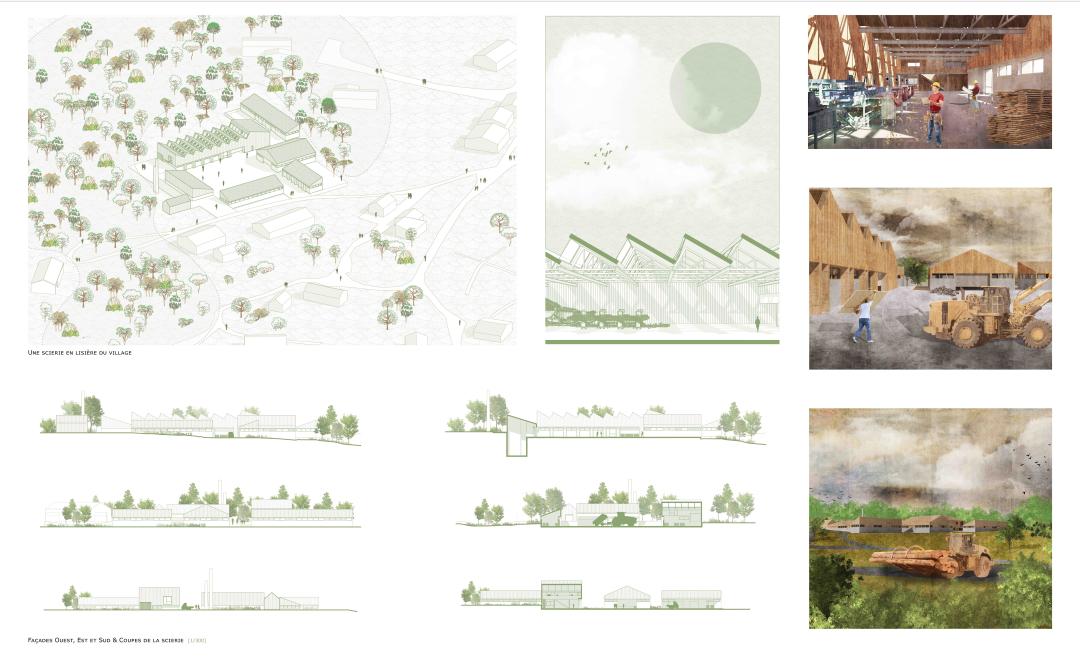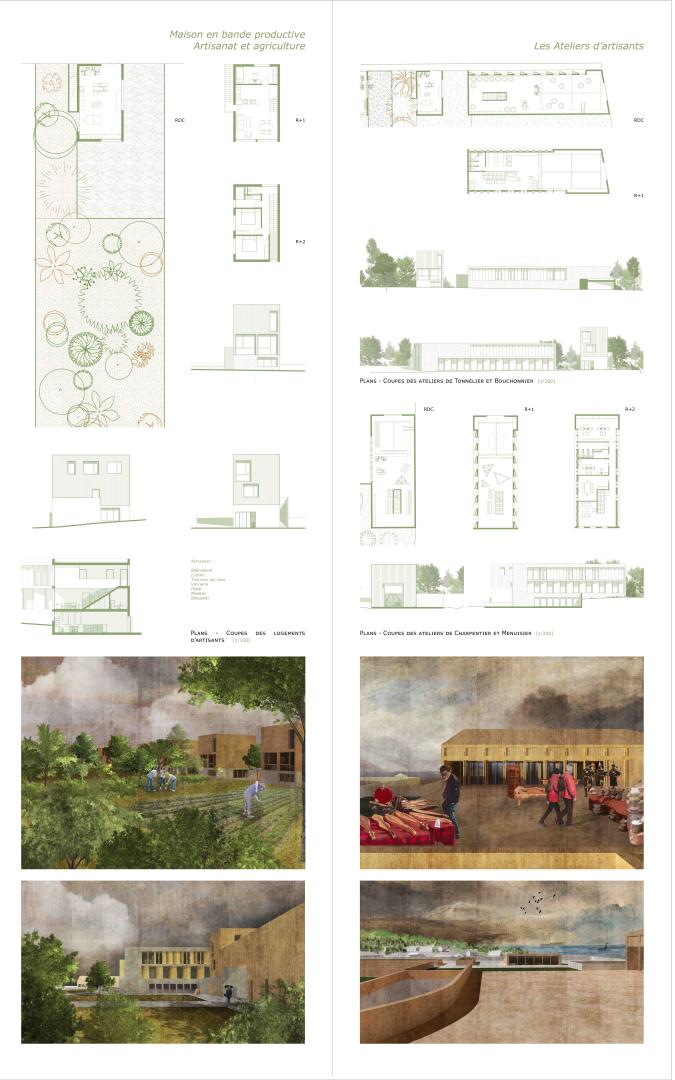Over the wood thread
Basic information
Project Title
Full project title
Category
Project Description
This diploma project is understood as the development and implementation of a new productive system, based on the existing Scottish reforestation campaigns. The project focuses on scripting the introduction of agro-forestry as a system. While striving to design the transformation of the landscape and soils with plots of agro-forestry, forest conservation, agriculture and reforestation, the project is thus interested in developing a resilient future for a rurality in search of regeneration.
Geographical Scope
Project Region
Urban or rural issues
Physical or other transformations
EU Programme or fund
Which funds
Description of the project
Summary
This diploma project is understood as the development and implementation of a new productive system, based on the existing Scottish reforestation campaigns. The project focuses on scripting the introduction of agro-forestry as a system, in Tolsta, a village of 500 people in the north of the Outer Hebrides archipelago, Scotland.
The scene of a 1500-tree plantation by the Woodland Croft Project in 2017 and 2018, this village appears to be an ideal setting for developing innovative approaches to richer, more productive and more resilient land use.
The idea of the project is to use this community impetus to establish sustainable forestry and thus create a new production system: Agroforestry. The aim is to use this system as a support for the economic development of rural areas in order to generate a repopulation.
The objective is then to translate spatially, programmatically and architecturally the impacts and needs of such a change. Defining an urban restructuring and a project temporality, this system translates into a varied programme with a sawmill and a boiler room, workshops for wood craftsmen, a producers’ market and a craft market, an agricultural cooperative, training and awareness-raising facilities and timber construction housing.
While striving to design the transformation of the landscape and soils with plots of agro-forestry, forest conservation, agriculture, pasture and diversified reforestation, the project is thus interested in developing a resilient future for a rurality in search of regeneration.
Key objectives for sustainability
With the increase in the rural exodus and the saturation of cities, it appears that the massive concentration of individuals is not necessarily a factor of sustainability. It is therefore becoming urgent to question the way we occupy the territory. «What is the most efficient [...] and ecologically sustainable distribution of a territory’s population, activities and associated services?». This sustainable arrangement of the territory is based on a more resilient distribution of the resource and equity in its accessibility and exploitation.
Today, the organisation of the territory is crystallised around the City/Rurality divide. A model established on the basis of a major entity, the metropolis, which radiates and gives life to neighbouring villages and towns, the latter being subject to its services, attractiveness and money. As an in-between territory, the rural aggregate is always relegated by the discourse on the metropolis. It is thus considered either as a space dependent on the city, or as an entity in a state of suspended animation, in full decline.
These «simplified and exhausted ecosystems», often built around a globalised, extensive and mono-cultural system of resource production, lead to a limited economy which today results in a low employment rate and the definite depopulation of the rural environment. It seems necessary to establish a new development model for these territories in order to recover a local and resilient production and consumption.
For a renaissance of these marginal communities, this system must be part of a new land use and diversification, while innovating in the management of existing or potential agricultural, ecological and forestry resources.
In Scotland, government, associations and rural communities have chosen reforestation and agroforestry as their response. This system is a new principle of rural development and could be summurize by "How to change the model of rurality by changing the landscape and reconecting to nature?
Key objectives for aesthetics and quality
As a factor of regenerating rural area, an industry will develop around the woodland resource. Small-scale sawmilling, woodworking, joinery, turning and coppicing crafts can all develop where the forest resources are of appropriate size and quality. They can form a cluster of interdependent enterprises sharing some resources and benefiting from common marketing and premises.
Sawmilling, secondary wood processing, workshops, manufacturing, timber housing construction all become symbiotic and therefore more economically viable.
Project strategy
The aim of the project is then :
1- To organise the use of the land between forestry, agriculture, pasture and forest conservation area (wood not intended for cutting);
2- To restructure the village in an urban way;
3- To design the organisation of production.
An agricultural bypass
To do this, the project creates an agricultural ring road around the village, linking the productive plots and hosting the programmes at the beginning of the chain - an agricultural cooperative, greenhouses, drying areas for wood and the sawmill. The raw material and the farmers can move around easily.
Secondly,
In the central basket-handle of the village, the end-of-chain programmes for the public are organised, symbolising the regeneration of the village.
There are handicraft workshops, a training and awareness facility, a market of producers and craftsmen, and some housing.
The Agricultural and Wood Chains work together in this system.
Each new building of the project has its own aesthetics thought different function, volumetry, construction principles and typology.
For example : The typology of the sawmill is a central courtyard. It is a productive courtyard that organises all the buildings around it and keeps the industrial noise inside the project. The craftsmen’s market on the belvedere, has a double-post façade whereas the workshop has a wooden panels facade.
Key objectives for inclusion
Various NGOs, such as the Woodland Trust at the UK level and Trees for Life in the Highlands, have long been committed to the re-introduction of community-based agroforestry for rural areas. Exploring the idea of citizen participation in the management of natural resources and land use, they have been running various reforestation projects since 1992, including the Woodland Croft Project, initiated in 2016 with the Point and Sandwick Trust, on the Outer Hebrides.
In a desire to reclaim its own future, the Point and Sandwick Trust, an association in the archipelago that supports the development of community projects in its villages, has launched the Woodland Croft Project.
In partnership with the Woodland Trust and other national forestry institutions, the Woodland Croft Project aims to create between 70 and 100 hectares of new woodland on the islands by 2020. Funded by the government, the association has already planted 100,000 trees in more than 50 villages throughout the archipelago. Today, 103 projects, more or less small, of «forest farms» have been created (0.1 hectare to 3 ha). The various rural communities have immediately taken up the project with great enthusiasm from the farmers, planting trees on their farms.
With a real commitment to making these plantations work, the project was extended into a second phase, funded at £400,000 over five years, projecting 250,000 trees planted by 2025.
The idea of the project is to use this community impetus to establish sustainable forestry and thus create a new production system: Agroforestry. The aim is to use this system as a support for the economic development of rural areas in order to generate a repopulation.
Physical or other transformations
Innovative character
Indeed, the reintroduction of agroforestry gives a new lease of life to these villages where the ageing of the population, the decline of agriculture and the reduction of local means of subsistence are a reality.
The aim is to use this system as a support for the economic development of rural areas to generate a repopulation.
The project is sustainable because of the way it takes care of the territory's organisation by regenerating rural areas and populations, and because of the proposed solution: reproducible, ecological, based on renewable resources. The project is inclusive because this process is only possible through the involvement of rural communities seeking to reclaim their territory and reconnect with nature. Finally, the project offers a functional architecture in symbiosis with the proposed vision: it promotes a biosourced architecture, built with the raw material provided by the local forests implanted by the project.
This system is Agroforestry. What is agroforestry? It is a balance between forestry and agriculture, both working in symbiosis and benefiting from each other.





